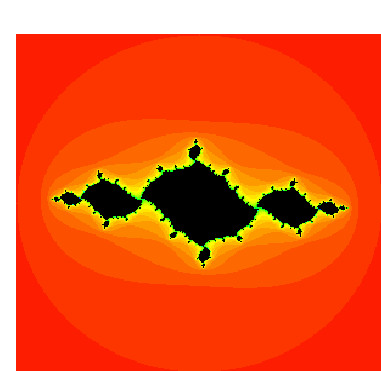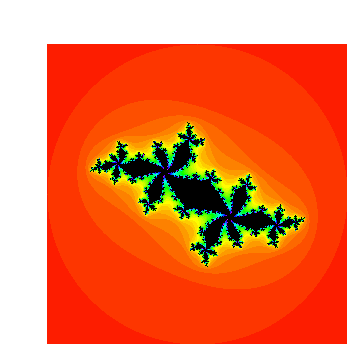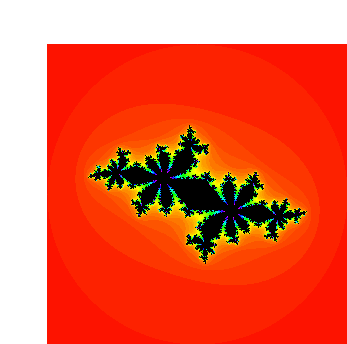 5 The fundamental dichotomy (Next Section)
5 The fundamental dichotomy (Next Section)
 Fractal Geometry of the Mandelbrot Set (Cover Page)
Fractal Geometry of the Mandelbrot Set (Cover Page)
 3 Periods of the Bulbs (Previous Section)
3 Periods of the Bulbs (Previous Section)
 BU Math Home Page
BU Math Home Page
There is a second, more dynamic way to calculate the periods of these
primary bulbs in M. To explain this, we have to introduce the
notion of a filled Julia set.
The filled Julia set for x2 + c is subtly different
from the Mandelbrot set.
For M, we calculated only the orbit of 0 for each c-value
and then displayed the result. A c-value lies in M if the
corresponding orbit of 0 does not escape to infinity. Thus, M
is a picture in the c-plane, the parameter plane.
For the filled Julia sets, we fix a c-value and then consider
the fate of
all possible seeds for that fixed value of c. Those seeds whose
orbits do not escape form the filled Julia set of x2
+ c. Caution: There is also a notion of the
Julia set. This term is used to describe the boundary of
the filled Julia set.
Orbits
that do escape do not lie in the filled Julia set. Thus we get a different
filled Julia set of each different choice of c. That is, the
filled Julia set is a
picture in the dynamical plane, not the parameter plane. We denote the
filled Julia set for x2 + c by
Jc. In Figure 7 we have displayed the
filled Julia sets for a variety of c-values.

c = -1.037 + 0.17i in a period 2 bulb

c = -0.52 + 0.57i in a period 5 bulb

c = 0.295 + 0.55i in a period 4 bulb

c = -0.624 + 0.435i in a period 7 bulb.
Figure 7. The filled Julia sets for several c-values
There is one c-value for which the filled Julia set is easy to
compute by hand, namely c=0. The filled Julia set for x2 + 0,
J0, is easily seen to be the unit disk centered at the
origin in the plane.
The reason is simple. Suppose that z0 is a seed. In
polar coordinates we may write
where t is the polar angle and r is the magnitude of
z0
But then the
orbit of z0 under x2 is
and so forth. The magnitude of zn is r2^n.
Thus, the orbit of x0 tends to infinity if r > 1
and to 0 if r < 1. If r = 1, the orbit of the seed remains trapped for all iterations on the unit circle.
It follows that any seed on or inside the circle of radius 1
centered at the origin has an orbit that does not escape to infinity.
It therefore follows
that J0 consists of all those seeds whose orbits lie on or insider
the unit circle centered at the origin.
Incidentally, the fate of orbits of x2 that lie on the unit circle
is quite an interesting story. These are precisely the orbits that
behave in a chaotic fashion. See [3]
for more details.
Other filled Julia sets are much more difficult to compute. To see them, we
must use a computer. The algorithm is, of course, a direct consequence
of the definition of Jc. We simply consider a grid of points
centered at the origin and compute the orbit of each of these points
under x2 + c.
Either this orbit tends to infinity (in which case the
seed was not in Jc) or else the orbit does not (and so the seed
lies in Jc).
Important Difference
The Mandelbrot set:
- is a picture in parameter space
- records the fate of the orbit of 0
The filled Julia set
- is a picture in dynamical plane
- records the fate of all orbits
 5 The fundamental dichotomy (Next Section)
5 The fundamental dichotomy (Next Section)
 Fractal Geometry of the Mandelbrot Set (Cover Page)
Fractal Geometry of the Mandelbrot Set (Cover Page)
 3 Periods of the Bulbs (Previous Section)
3 Periods of the Bulbs (Previous Section)
 BU Math Home Page
BU Math Home Page
Prof. Robert L. Devaney (Boston University)




 5 The fundamental dichotomy (Next Section)
5 The fundamental dichotomy (Next Section) Fractal Geometry of the Mandelbrot Set (Cover Page)
Fractal Geometry of the Mandelbrot Set (Cover Page) 3 Periods of the Bulbs (Previous Section)
3 Periods of the Bulbs (Previous Section) BU Math Home Page
BU Math Home Page